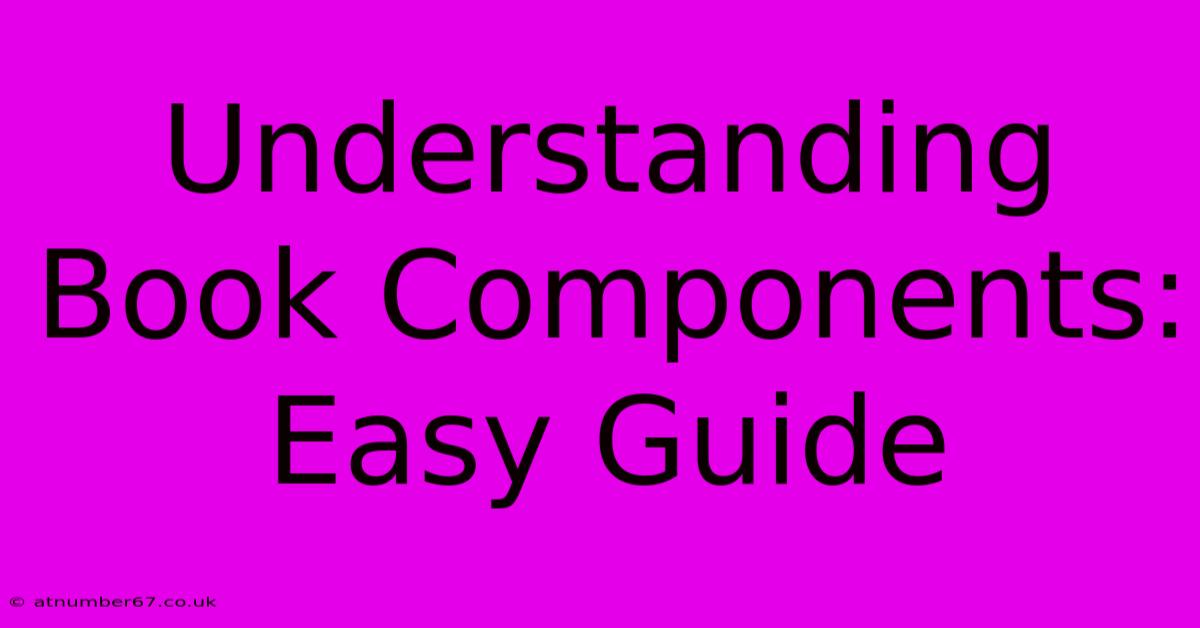Understanding Book Components: Easy Guide

Table of Contents
Understanding Book Components: An Easy Guide
So you're thinking about writing a book, or maybe you're just curious about what goes into making one? Understanding the different components of a book is crucial, whether you're an aspiring author, a budding editor, or simply a book lover. This guide will break down the key elements, providing a clear and concise overview.
The Front Matter: Setting the Stage
Before the actual story begins, several elements prepare the reader for the journey ahead. These are collectively known as the front matter.
1. Title Page: The First Impression
This is arguably the most important page. It includes:
- Title: The name of your book – make it catchy and reflective of the content!
- Subtitle: (Optional) Adds context and clarifies the main title.
- Author Name: Your name, or the names of the authors.
- Publisher: The company responsible for publishing the book.
- Publication Date: The year (and sometimes month) the book was released.
2. Copyright Page: Legal Niceties
This page protects your intellectual property and includes:
- Copyright Notice: States the copyright holder and year.
- ISBN: The International Standard Book Number, a unique identifier.
- Library of Congress Control Number (LCCN): A unique identifier used by US libraries.
- Publisher Information: Contact details of the publisher.
3. Dedication (Optional): A Personal Touch
A heartfelt dedication to a person or group who inspired you.
4. Table of Contents: Your Roadmap
Provides a structured overview of the book's chapters and sections, along with page numbers. It’s essential for navigation.
5. Preface or Foreword: Setting the Context
- Preface: Written by the author, offering insights into the book's creation and purpose.
- Foreword: Written by someone other than the author, often an expert in the field, providing an endorsement and overview.
The Main Body: The Heart of the Matter
This is where the magic happens – the actual content of your book. It's organized into chapters, and sometimes sections within chapters. The structure will depend on the genre and the author's style, but clarity and a logical flow are key.
Chapter Structure: Building Blocks of Your Story
Each chapter should contribute to the overall narrative or argument. Effective chapter breaks keep the reader engaged and prevent information overload.
The Back Matter: Wrapping it Up
The back matter provides additional resources and information for the reader.
1. Epilogue (Optional): A Final Reflection
Provides concluding thoughts, a summary, or hints at future developments.
2. Appendix (Optional): Supplementary Material
Includes extra information, data, tables, or other materials that support the main text but are not essential to the narrative flow. Think maps, charts, or detailed technical specifications.
3. Glossary (Optional): Defining Key Terms
Provides definitions of specialized terms used within the book. Crucial for academic or technical works.
4. Bibliography or Works Cited: Giving Credit Where Credit is Due
Lists all the sources used in writing the book, adhering to a specific citation style (MLA, APA, Chicago, etc.). This demonstrates academic integrity and allows readers to further their research.
5. Index (Optional): For Easy Searching
An alphabetical list of names, topics, and keywords with corresponding page numbers. Essential for non-fiction and reference books.
Conclusion: The Complete Package
Understanding these components allows you to appreciate the intricate process of book creation. Whether you are writing, editing, or simply reading, recognizing the purpose of each part enhances your overall experience and understanding. Remember, a well-structured book is a pleasure to read and a testament to careful planning and execution. Happy reading (and writing)!

Thank you for visiting our website wich cover about Understanding Book Components: Easy Guide. We hope the information provided has been useful to you. Feel free to contact us if you have any questions or need further assistance. See you next time and dont miss to bookmark.
Featured Posts
-
Unlocking The Secrets Of Michael Polanskys Wealth
Mar 31, 2025
-
Jonty Rhodes Age Fitness Goals For Every Age
Mar 31, 2025
-
Is Elon Musk The Richest Person Real Time Answer
Mar 31, 2025
-
From Damaged To Divine Carols Daughter Goddess Strength
Mar 31, 2025
-
Korku Kapani The Ultimate Anxiety Self Help Guide
Mar 31, 2025
